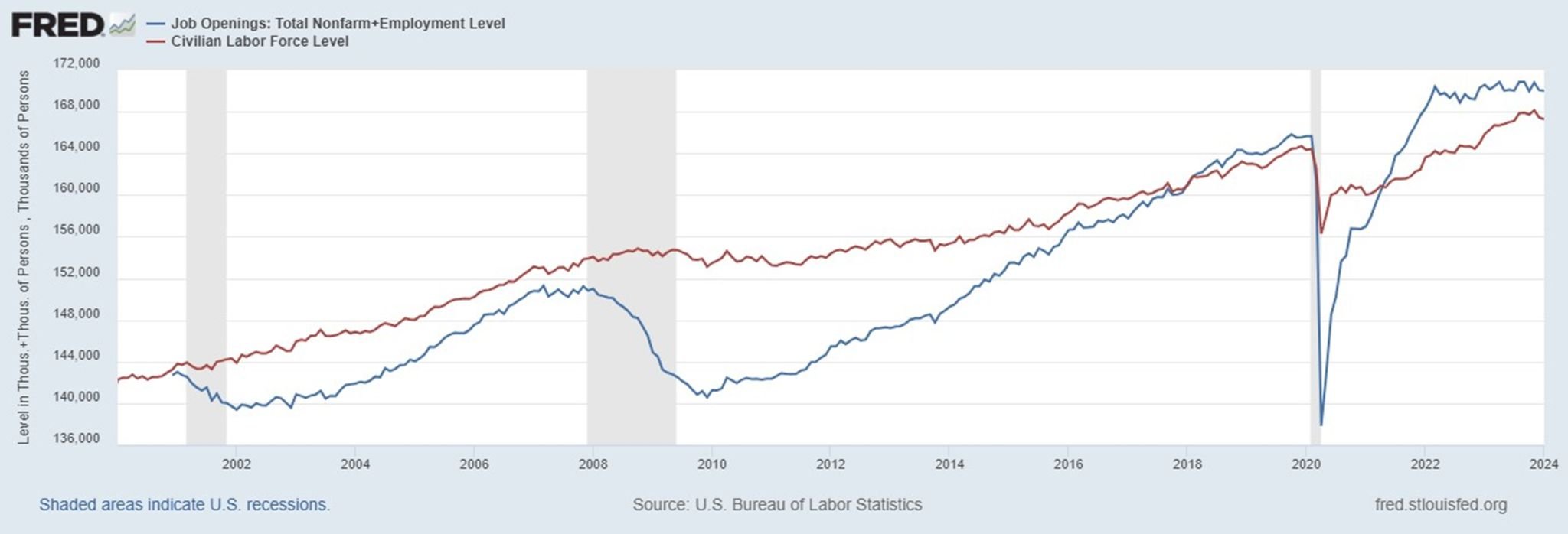The Numbers Don’t Lie: What the Data Tells Us About the Labor Market
If I had a dollar for every time someone asked me about what was going on in the labor market, I would be a very rich person indeed. So, when we had the opportunity to present to a group of South Carolina CFOs in March, we did a deep dive into the labor market data. At the end of the day, the data matters a whole lot more than what we think. What does the data say?
It's a crucial question that demands a thoughtful answer. Why? Because the accuracy of our suppositions about the labor market creates the foundation for our strategy: how we go to market, what we flex on, how we compensate our employees, and so on.
The first, and most important point, is that the pinch in the labor market is a systemic problem that was NOT caused by COVID. This trend has been “in the making" for years now, as you can see in the job openings / civilian labor force level chart below.
The blue line indicates job openings. The red line indicates the civilian labor force level. As you can see (and possibly remember), the economy took a swan dive in 2008. Ever since then, the job openings have been creeping back up and in 2018, they surpassed the civilian labor force. COVID had a significant, short-term impact but the disparity is continuing to grow. In short, there are more jobs than people!
What is driving the shortage?
We see four main factors driving the shift in the labor market:
Rise of entrepreneurship: Entrepreneurship and side hustles are real. In 2020, 2 million individuals made six figures or more on social media.
An aging workforce: The workforce is continuing to age out. Over 3 million adults took early retirement packages during the COVID crisis.
Declining birthrates: This goes hand in hand with the previous point. Americans are having fewer babies than before, which all adds up to a reduced workforce.
Decrease of women participating: Women, particularly mothers, have continued to opt out of the workforce, with a participation rate dropping from the all-time high of 60.1% in 2000 to 57.6% in 2023.
What you can do:
Aside from having more children, there isn’t much you can do to control any of the above. But you do control how you go about the hiring process. Here’s what you can do:
Create an appealing opportunity.
How can you create a position that people are excited about? Most candidates are specifically looking for the following:
Opportunities to learn new technical and leadership skills (personal and professional growth).
Reasonable and flexible working hours
Exposure to leadership
Hybrid location if possible (3/2 or 4/1 ideal)
Meaning in their work — what are your mission, vision, and values?
Think about
Craft the sizzle.
Most candidates, especially at the junior and mid-career point, have multiple opportunities they are considering. Ask and answer these questions to create selling points:
“Why is this a great place to work?”
“What impact will I have on the organization as a whole?”
“How will this role/company impact my career?”
“What will my team look like?”
Share the sizzle.
If a tree falls in a forest, and no one hears it, does it make a sound? Overused but true… It doesn’t matter how good your sizzle is if you aren’t sharing it.
Facilitate dialogue with your recruiting team and hiring managers. (Help them help you).
Create an active presence on LinkedIn.
Work with marketing (or even outsource it) if you need help coming up with a branded Employee Value Proposition.
Be a Hunter, not a Farmer.
Waiting on applicants is like waiting for crops to grow . . . without sowing any seed. We call it the “post and pray” method. Candidates are not applying these days.
Reach out to your network.
Utilize LinkedIn for proactive recruiting.
Utilize external recruiters for important or hard-to-fill roles.
Ultimately, you don’t control the economy or the labor market. But you can control how you go to market with the open roles at your company. If you want to chat, send us a note! We’re happy to help evaluate the appeal of your opportunity.


